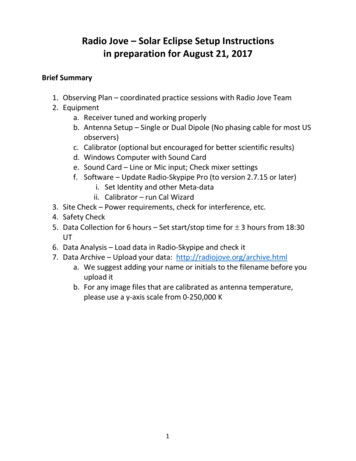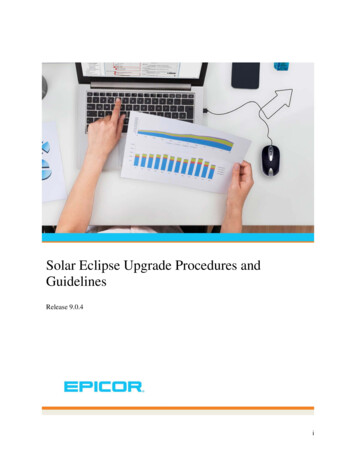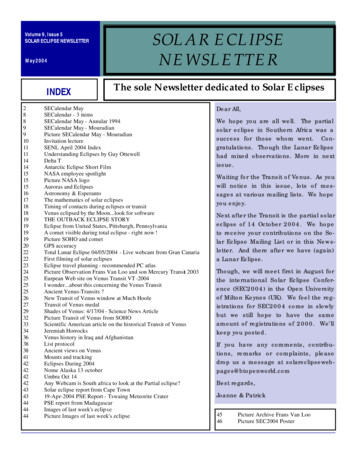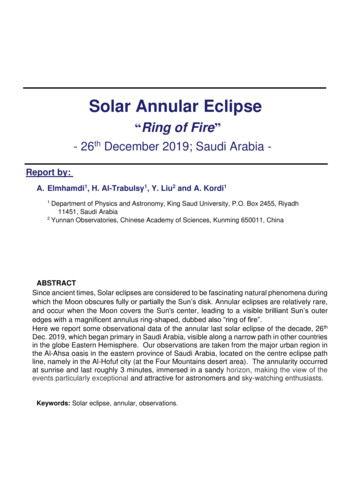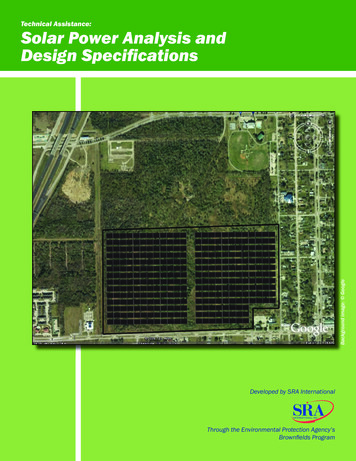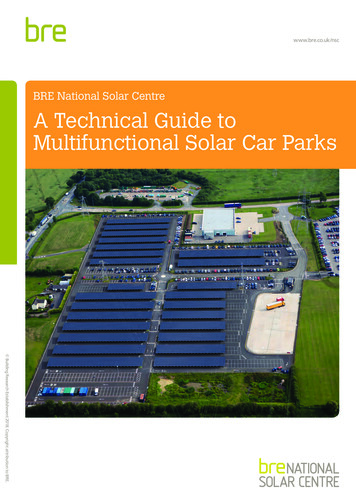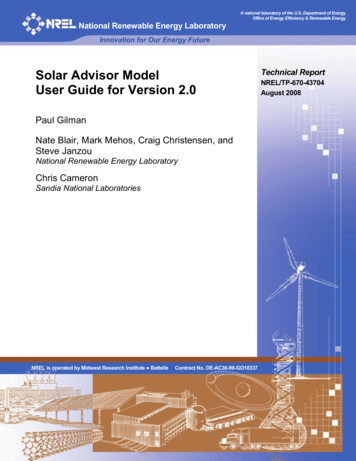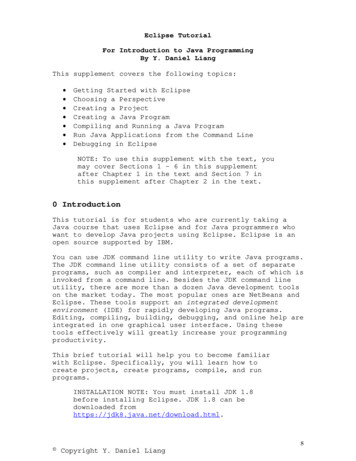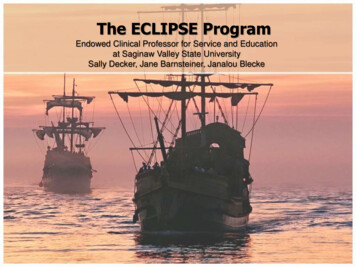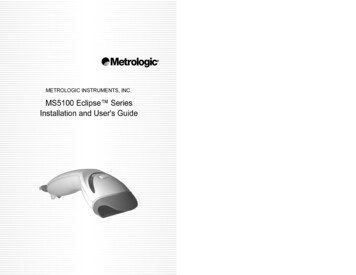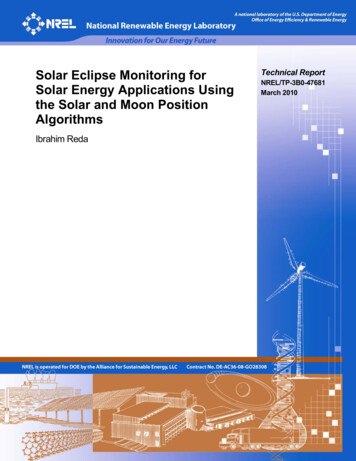
Transcription
Solar Eclipse Monitoring forSolar Energy Applications Usingthe Solar and Moon PositionAlgorithmsIbrahim RedaTechnical ReportNREL/TP-3B0-47681March 2010
Solar Eclipse Monitoring forSolar Energy Applications Usingthe Solar and Moon PositionAlgorithmsIbrahim RedaPrepared under Task No. 3B10.3000National Renewable Energy Laboratory1617 Cole Boulevard, Golden, Colorado 80401-3393303-275-3000 www.nrel.govNREL is a national laboratory of the U.S. Department of EnergyOffice of Energy Efficiency and Renewable EnergyOperated by the Alliance for Sustainable Energy, LLCContract No. DE-AC36-08-GO28308Technical ReportNREL/TP-3B0-47681March 2010
NOTICEThis report was prepared as an account of work sponsored by an agency of the United States government.Neither the United States government nor any agency thereof, nor any of their employees, makes anywarranty, express or implied, or assumes any legal liability or responsibility for the accuracy, completeness, orusefulness of any information, apparatus, product, or process disclosed, or represents that its use would notinfringe privately owned rights. Reference herein to any specific commercial product, process, or service bytrade name, trademark, manufacturer, or otherwise does not necessarily constitute or imply its endorsement,recommendation, or favoring by the United States government or any agency thereof. The views andopinions of authors expressed herein do not necessarily state or reflect those of the United Statesgovernment or any agency thereof.Available electronically at http://www.osti.gov/bridgeAvailable for a processing fee to U.S. Department of Energyand its contractors, in paper, from:U.S. Department of EnergyOffice of Scientific and Technical InformationP.O. Box 62Oak Ridge, TN 37831-0062phone: 865.576.8401fax: 865.576.5728email: mailto:reports@adonis.osti.govAvailable for sale to the public, in paper, from:U.S. Department of CommerceNational Technical Information Service5285 Port Royal RoadSpringfield, VA 22161phone: 800.553.6847fax: 703.605.6900email: orders@ntis.fedworld.govonline ordering: http://www.ntis.gov/ordering.htmPrinted on paper containing at least 50% wastepaper, including 20% postconsumer waste
AcknowledgmentsI would like to thank Bev Kay for typing all the data tables in the report into text files, which madethem easy and timely to transport to the report text and to the software code. Thanks also to DarylMyers for his technical expertise in solar radiation applications. I extend special appreciation tomy wife, Mary Alice, and my daughter, Lenah, for their inspiration about the Moon’s influence onromance, legends, and art. I also thank Henry Higaki, my center director, for providing the funds,his continuous support, and his trust in me and my abilities. Finally, many thanks to Leigh Ramseyfor her help during the publishing process and Stefanie Woodward for her great effort in editingand formatting the text of this article.iii
AcronymsAAAstronomical AlmanacAUastronomical unitJCJulian centuryJDJulian dayJDEJulian ephemeris dayJMEJulian ephemeris millenniumMPAmoon position algorithmSAMPAsolar and moon position algorithmSPAsolar position algorithmSULSun’s unshaded luneTAIinternational atomic timeTDTterrestrial dynamical timeTTterrestrial timeUTuniversal timeUTCcoordinated universal timeiv
Executive SummaryThe Moon has always played an important role in human culture. It forms the basis of Babylonian,Jewish, and Islamic calendars; it determines the timing of the Christian Easter (which is always thefirst Sunday after the first full Moon after the vernal equinox). It makes an important contributionto the settings in paranormal and romantic legends and poetry; even cartoons, such as Inuyashawhere a half-demon becomes human on the night of New Moon, depend for their stories on thelunar cycle. The Harvest Moon, New Moon and Blue Moon are important in agriculture andastronomy, and man has long used the Moon to navigate travel and predict tides.In recent years the interest in using solar energy as a major contributor to renewable energyapplications has increased, and the focus on smart grids to optimize the use of electrical energybased on demand and resources from different locations has strengthened. We thus need tounderstand the Moon’s position with respect to the Sun. For example, during a solar eclipse, theSun might be totally or partially shaded by the Moon at the site of interest, which can affect theirradiance level from the sun’s disk. A resource on the grid might be affected by this.Instantaneously predicting and monitoring a solar eclipse can provide smart grid users withinstantaneous information about potential total or partial solar eclipse at different locations soother resources can instantaneously be directed to a specific location. At least five solar eclipsesoccur yearly, and can last few hours, depending on location. This rare occurrence can havedevastating effects on smart grid users.This report includes a procedure for implementing an algorithm (described by Jean Meeus [1]) tocalculate the Moon’s zenith angle with uncertainty of 0.001 and azimuth angle with uncertaintyof 0.003 . The step-by-step format presented here simplifies the complicated steps Meeusdescribes to calculate the Moon’s position, and focuses on the Moon instead of the planets andstars. It also introduces some changes to accommodate for solar radiation applications. Theseinclude changing the direction of measuring azimuth angles from north and eastward instead offrom south and eastward, and the direction of measuring the observer’s geographical longitude tobe measured as positive eastward from Greenwich meridian instead of negative. In conjunctionwith the solar position algorithm that Reda and Andreas developed in 2004 [2], the angulardistance between the Sun and the Moon is used to develop a method to instantaneously monitor thepartial or total solar eclipse occurrence for solar energy applications and smart grid users. Thismethod can be used in many other applications for observers of the Sun and the Moon positions forapplications limited to the stated uncertainty.v
ContentsAcknowledgments. iiiAcronyms . ivExecutive Summary . vFigures. viiTables . vii1.0Introduction . 12.0Time Scale . 23.0Moon Position Algorithm . 33.1.Calculate the Julian and Julian Ephemeris Day, Century, and Millennium:. 33.2.Calculate the Moon Geocentric Longitude, Latitude, and Distance Between theCenters of Earth and Moon (λ, β, and Δ) . 43.3.Calculate the Moon’s Equatorial Horizontal Parallax, π. 83.4.Calculate the Nutation in Longitude and Obliquity (Δψ and Δε) . 93.5.Calculate the True Obliquity of the Ecliptic, ε (in degrees) . 123.6.Calculate the Apparent Moon Longitude, λ (in degrees) . 133.7.Calculate the Apparent Sidereal Time at Greenwich at Any Given Time, ν(in degrees). 133.8.Calculate the Moon’s Geocentric Right Ascension, α (in degrees) . 133.9.Calculate the Moon’s Geocentric Declination, δ (in degrees) . 133.10. Calculate the Observer Local Hour Angle, H (in degrees) . 133.11. Calculate the Moon’s Topocentric Right Ascension α’ (in degrees) . 143.12. Calculate the Topocentric Local Hour Angle, H’ (in degrees) . 153.13. Calculate the Moon’s topocentric zenith angle, θm (in degrees) . 153.14. Calculate the Moon’s Topocentric Azimuth Angle, Φm (in degrees) . 154.0Moon Position Algorithm Validation . 165.0Predicting and Monitoring the Solar Eclipse Occurrence . 175.1.Calculate the Local Observed, Topocentric, Angular Distance Between the Sun andMoon Centers, Ems (in degrees) . 175.2.Calculate the Radius of the Sun’s Disk, rs (in degrees). 175.3.Calculate the Radius of the Moon’s Disk, rm (in degrees) . 185.4.Set the Boundary Conditions for the Solar Eclipse . 186.06.1.Estimating the Solar Irradiance During a Solar Eclipse . 19Calculate the Area of SUL, ASUL . 20vi
7.6.2.Calculate the Percentage Area of the SUL With Respect to the Area of the Sun’s Disk,%ASUL . 206.3.Calculate the Direct Beam Irradiance Using the Appropriate Model for the RequiredUncertainty, in W/m2 . 206.4.Calculate the Irradiance (W/m2) During the Eclipse, I e . 20Conclusions . 21References . 22FiguresFigure 1. Difference between the AA and MPA for the Moon’s declination . 16Figure 2. Difference between the AA and MPA for the Moon’s horizontal parallax . 17Figure 3. Distance between the Sun and Moon centers and the percentage of the SUL for the . 19Figure 4. Measured irradiance versus calculated irradiance using SAMP during theJune 10, 2002 partial solar eclipse . 21Figure A.2.1. Intersecting circles to calculate the areas of the Sun and Moon lunes . 24TablesTable 1. Moon’s Periodic Terms for Longitude and Distance. 5Table 2. Periodic Terms for the Moon’s Latitude. 6Table 3. Periodic Terms for the Nutation in Longitude and Obliquity. 10Table 4. Historical Solar Eclipses Versus SAMPA Eclipse Monitor, Ems. 19Table A.1.1. Example to Compare Users’ Calculations to SAMPA . 23Table A.1.2. SAMPA Results . 23vii
1.0IntroductionThe Moon has always played an important role in human culture. It forms the basis of Babylonian,Jewish, and Islamic calendars; it determines the timing of the Christian Easter (which is always thefirst Sunday after the first full Moon after the vernal equinox). It makes an important contributionto the settings in paranormal and romantic legends and poetry; even cartoons, such as Inuyashawhere a half-demon becomes human on the night of New Moon, depend for their stories on thelunar cycle. The Harvest Moon, New Moon and Blue Moon are important in agriculture andastronomy, and man has long used the Moon to navigate travel and predict tides.In recent years the interest in using solar energy as a major contributor to renewable energyapplications has increased, and the focus on smart grids to optimize the use of electrical energybased on demand and resources from different locations has strengthened. We thus need tounderstand the Moon’s position with respect to the Sun. For example, during a solar eclipse, theSun might be totally or partially shaded by the Moon at the site of interest, which can affect theirradiance level from the sun’s disk. A resource on the grid might be affected by this.Instantaneously predicting and monitoring a solar eclipse can provide smart grid users withinstantaneous information about potential total or partial solar eclipse at different locations soother resources can instantaneously be directed to a specific location. At least five solar eclipsesoccur yearly, and can last few hours, depending on location. This rare occurrence can havedevastating effects on smart grid users.This report includes a procedure for implementing an algorithm (described by Jean Meeus [1]) tocalculate the Moon’s zenith angle with uncertainty of 0.001 and azimuth angle with uncertaintyof 0.003 . The step-by-step format presented here simplifies the complicated steps Meeusdescribes to calculate the Moon’s position, and focuses on the Moon instead of the planets andstars. It also introduces some changes to accommodate for solar radiation applications. Theseinclude changing the direction of measuring azimuth angles from north and eastward instead offrom south and eastward, and the direction of measuring the observer’s geographical longitude tobe measured as positive eastward from Greenwich meridian instead of negative.First, the Moon position is calculated, then, in conjunction with the solar position algorithm thatReda and Andreas developed [2], the angular distance between the Sun and the Moon is used todevelop a method to instantaneously monitor the partial or total solar eclipse occurrence for solarenergy applications and smart grid users. SPA [2] has the details of calculating the solar position,so only the Moon position algorithm (MPA) is included in this report. When the solar positioncalculation is included in this report, the SPA report will be the source for the SPA calculation.This method can be used in many other applications for observers of the Sun and the Moonpositions for applications limited to the stated uncertainty.This report: Describes the time scales because using the correct time in MPA is important Provides a step-by-step procedure to calculate the Moon position Evaluates the Moon’s position against the Astronomical Almanac (AA) [3] data for 1981,and 2004 through 2010.1
Monitors the solar eclipse occurrence using the Solar and Moon position algorithms,(SAMPA) Compares SAMPA against historical eclipses Describes a method to estimate the irradiance level during the solar eclipse occurrence.Because the algorithm is complex, an example is included in Appendix A.1, Table A.1.1 to givethe users confidence in their step-by-step calculations; SAMPA results are in Table A.1.2.This report is used to calculate the Moon’s position for solar radiation applications. It is purelymathematical and not meant to teach astronomy or to describe the Moon rotation around the Earth.For more information about the astronomical nomenclature that is used throughout the report,review the definitions in AA or another astronomy reference.2.0Time ScaleFollowing are the internationally recognized time scales: Universal time (UT), or Greenwich civil time, is based on the Earth’s rotation andreferenced to 0-hour at midnight; the unit is mean solar day [3]. UT is used to calculate thesolar position in the described algorithm. It is sometimes referred to as UT1. International atomic time (TAI) is the duration of the System International Second(SI-second) and based on a large number of atomic clocks [3]. Coordinated universal time (UTC) is the basis of most radio time signals and legal timesystems. It is kept to within 0.9 seconds of UT1 (UT) by introducing one-second steps to itsvalue (leap second); to date the steps are always positive. Terrestrial dynamical or terrestrial time (TDT or TT) is the time scale of ephemerides forobservations from the Earth’s surface.The following equations describe the relationship between the above time scales (in seconds):TT TAI 32.184 ,(1)UT TT T(2),where:ΔTis the difference between the Earth’s rotation time and TT. It is derived fromobservation only and reported yearly in the AA [5].UT UT 1 UTC UT 1 ,where:2(3)
ΔUT1 is a fraction of a second, positive or negative value that is added to the UTC toadjust for the Earth’s irregular rotational rate. It is derived from observation, butpredicted values are transmitted in code in some time signals; e.g., weekly by theU.S. Naval Observatory [4].3.0Moon Position Algorithm3.1.Calculate the Julian and Julian Ephemeris Day, Century, and Millennium:The Julian date starts on January 1, in the year –4712 at 12:00:00 UT. The Julian Day (JD) iscalculated using UT and the Julian Ephemeris Day (JDE) is calculated using TT. In the followingsteps, there is a 10-day gap between the Julian and Gregorian calendars where the Julian calendarends on October 4, 1582 (JD 2299160), and after 10 days the Gregorian calendar starts onOctober 15, 1582.3.1.1Calculate the Julian DayJD INT ( 365.25 * ( Y 4716)) INT ( 30.6001 * ( M 1)) D B 1524.5 ,(4)where:INTis the integer of the calculated terms (8.7 8, 8.2 8, and -8.7 -8, etc.).Yis the year (2001, 2002, etc.).Mis the month of the year (1 for January, etc.). If M 2, then Y and M are notchanged, but if M 1 or 2, then Y Y-1 and M M 12.Dis the day of the month with decimal time (e.g., for the second day of the month at12:30:30 UT, D 2.521180556).Bis equal to 0, for the Julian calendar {i.e. by using B 0 in Equation 4, JD 2299160}, and equal to (2 - A INT (A/4)) for the Gregorian calendar {i.e. by usingB 0 in Equation 4, and if JD 2299160}; A INT(Y/100).Users who wish to use their local time instead of UT should change the time zone to a fraction of aday (by dividing it by 24), then subtract the result from JD and note the change of the local date.The fraction is subtracted from JD calculated before the test for B 2299160 to maintain the Julianand Gregorian periods.3.1.2.Calculate the Julian Ephemeris DayJDE JD 3 T.86400(5)
3.1.3.Calculate the Julian Century and the Julian Ephemeris Century for the2000 Standard EpochJC JD 2451545,36525JCE 3.1.4.(6)JDE 2451545.36525(7)Calculate the Julian Ephemeris Millennium for the 2000 Standard EpochJME 3.2.JCE10.(8)Calculate the Moon Geocentric Longitude, Latitude, and Distance Betweenthe Centers of Earth and Moon (λ, β, and Δ)“Geocentric” means that the Moon position is calculated with respect to Earth’s center.3.2.1. Calculate the Moon’s Mean Longitude, L’ (in degrees)L' 218.3164477 481267.88123421 * T 0.0015786 * T 2 where:T3.2.2.T3T4 538841 65194000 ,(9)is JCE from Equation 7.Calculate the Mean Elongation of the Moon, D (in degrees)T3T4D 297.8501921 445267.1114034 * T 0.0018819 * T 545868 113065000 .23.2.3.(10
First, the Moon position is calculated, then, in conjunction with the solar position algorithm that Reda and Andreas developed [2], the angular distance between the Sun and the Moon is used to develop a method to instantaneously monitor the partial or total solar eclipse occur

